Australia’s solution to “ecological grief”
Rain finally started falling from the dark clouds above the banks of the Hawkesbury River in the small town of Yarramundi, located 70km north-west of Sydney at the base of the Blue Mountains.
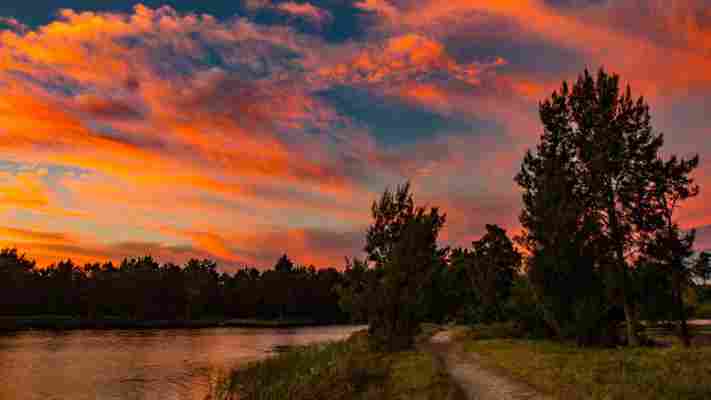
It was the last week of summer and it was the first week of rain since the horrific wildfires that burned 80% of the Blue Mountains’ forests from December 2019 to February 2020. The mist was balm after months of choking smoke. As I drove past, a cormorant was flapping its wings, perched on a log in the sandy shallows of the river, enjoying the rain along with a group of paddling ducks.
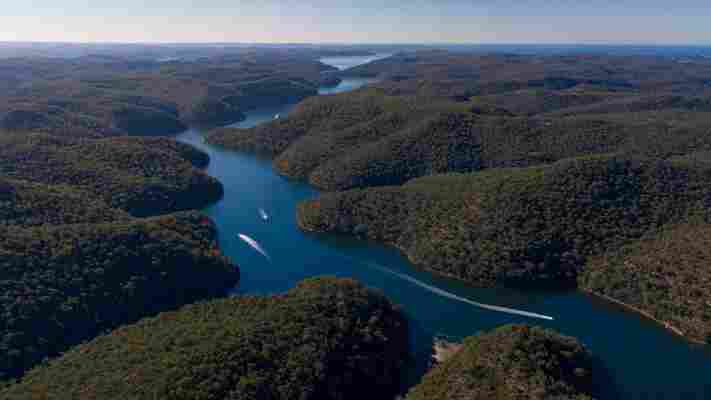
The magnificent Hawkesbury River is a place of great cultural significance to Australia’s Aboriginal people (Credit: Shells1/Getty Images)
The Hawkesbury River, known as Deerubin in the local Darug Aboriginal language, is part of a large and rich archaeological and anthropological area that reaches from the Blue Mountains in the west up to the Hunter Valley and Lake Macquarie in the north and out to sea. Much of this region has sacred and ceremonial significance to Australia’s Aboriginal peoples.
Our country has been under stress for a long time
Yarramundi, which means “storyteller” in Darug, in particular was a place of gathering, teaching and storytelling, which often involved singing. Singing is fundamental to Aboriginal culture, partly as it is an oral, not a written, culture. Here, Aboriginal elders told their grandchildren about the great eel or rainbow serpent that forged a meandering path through the chasms and snake-like bends that make up the great Hawkesbury River. Today, Aboriginal people still come here with their families, but drought and fire have diminished many places of cultural significance as there are fewer of the fish, birds and trees that feature in ancient stories.
I was on my way to attend an Aboriginal weekend choir workshop called Singing Deerubin Shores in Richmond 10km up the Hawkesbury River from Yarramundi. The workshop was hosted by Darug musicians who offer singing workshops each year to Aboriginal and non-Aboriginal people to revitalise their language. The choir workshops are becoming popular as non-Aboriginal people are becoming more curious about Australian languages.
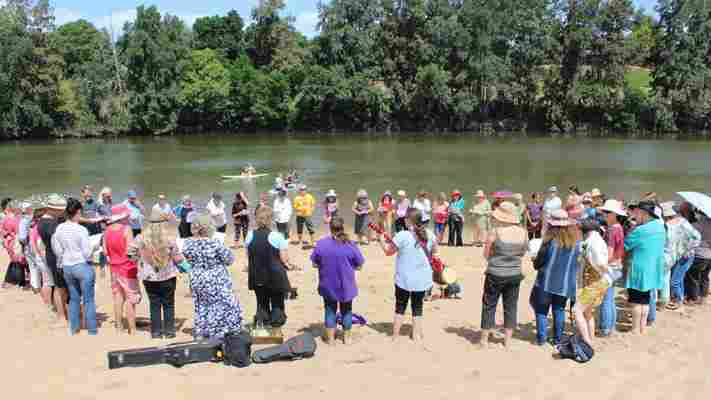
The Deerubin Shores choir brings together Aboriginal and non-Aboriginal Australians to sing and heal (Credit: Liz Phillips)
This year the workshop also had another aim: to offer healing after the fires. I craved fresh air to breathe and the support of community after months of anxiety during the wildfires. It was a month before Covid-19 lockdown and my mind was full of the horror of the fires. Living in the Blue Mountains, our home was surrounded by two huge blazes a few kilometres away that burned out of control for months. During the fires, I couldn’t talk much due to choking on smoke.
You may also be interested in: • A 60,000-year-old cure for depression • The food that defines Australia • Australia's fairy-tale island
I soon realised I was not alone in these feelings. Scores of people travelled here from fire- and drought-affected Australia to sing and heal; many of us suffering from “ecological grief”, a term used by psychologists to explain the loss people feel from environmental destruction, often caused by climate change.
“I feel a kind of numbness as the fires seem to have been downplayed now in the media, although so many people's lives have changed forever,” said Susan Ambler, who had come from the Upper Blue Mountains to sing and learn some Darug. Like me, she came to bond through singing and learn from Aboriginal people about survival and hope. The fires had proven to many of us how poorly non-indigenous Australians have looked after this country.
The Blue Mountains World Heritage Area is located in New South Wales, about two hours’ drive west of Sydney (Credit: Narvikk/Getty Images)
Jacinta Tobin, one of the Darug musicians and organisers of the choir, explained the power of healing through song to us as we gathered together in the community hall in Richmond.
“We are revitalising our language and trying to bring back that stronger connection to country through song. Our country has been under stress for a long time, and hopefully by sharing our culture with others, we may be able to walk together to bring back the respect and practice of those old ways.”
Another guest from the Blue Mountains, David Taylor, told me he came partly to explore Aboriginal ideas about mindfulness. “Our worldview is based on a sense of separation,” he said. “We've built a system based on money, put a price on ourselves and others, and neglected the truly valuable things.”
In contrast, Aboriginal culture has a very strong understanding of “Country”, the belief that the land, people, animals and society are inseparable. If animals and nature suffer, so do we.
Wildfires burned 80% of the Blue Mountains’ forests between December 2019 and February 2020 (Credit: Philip Wittke/Getty Images)
In the hall, about 60 people sat in a circle. It took a while to remember whether we were soprano, alto or bass and where in the circle we should sit. It had been decades since some of us had sung, let alone in a choir.
We followed the lead of Stacy Etal, a Darug woman and musician who was instructing us, along with Tobin and non-Aboriginal singing teacher, Rachel Hore.
Etal started with a song she composed in Darug, along with its English translation.
“Let’s sing to the Darug spirits Who remain on this land still Seeking the wisdom of the dreaming To help the land and people heal”
Meanwhile, Tobin coached a small group of men singing bass. She could reach some pretty low notes herself. “I can sing bass but not basso profundo. I can’t sing those real deep notes as I just smoke tobacco, not chew it like our mob out in the central deserts!” she laughed.
Jacinta Tobin is a Darug musician and one of the organisers of the choir (Credit: Liz Phillips)
We joined our voices in harmony as the rain started to fall heavier on the roof.
In some Aboriginal communities, there are people called “rainmakers” who in times of drought would bring rain through rituals of song, dance and ceremony. It’s an ancient practice where people sing to a river with their spirit ancestors to bring it back to life.
I was surprised to see just how many choirs existed in the desert communities
These traditions are still important. Aboriginal people realise they cannot actually make rain fall, but without the rivers flowing regularly due to drought and the impacts of climate change, “singing to the river” has strong symbolism, showing a need to look after the environment better.
Some Aboriginal people who are descended from the rainmakers are now working in environmental advocacy and as scientists to make rivers and waterways healthy again, such as in the Murray Darling basin, containing Australia’s longest river flowing through New South Wales, Victoria and South Australia.
Most Australians won’t know that words like wallaby and koala come from the Darug Aboriginal language (Credit: Fairfax Media/Getty Images)
Others have formed Aboriginal choirs, like the one I was attending, as a response to ecological stress. Singing Deerubin Shores, however, has a surprising source.
It was more than 20 years ago when Hore first sang with Aboriginal choirs in the deserts of Western and Central Australia. She was fascinated by the new sounds she heard; the rhythms and tones of local Aboriginal languages.
“I was surprised to see just how many choirs existed in the desert communities,” she said, noting that the desert opened her eyes and ears.
She became hooked on singing with Aboriginal choirs, and in 1998 she became the musical director of a large choir called Many Roads One Voice in the central Australian town of Alice Springs. That led her to set up Big Sing in the Desert , where Aboriginal elders now teach songs to others every year.
The Blue Mountains’ one million hectares takes in tall forests, sandstone cliffs, canyons and waterfalls (Credit: Kimonofish/Getty Images)
Hore could see how non-indigenous Australians wanted to learn singing and about indigenous culture from Aboriginal people. People who came to the choirs spoke of feeling removed from nature and in need of connection with the land.
So many Australians don’t realise they already know a few Darug words, like wallaby and koala
“I felt there was a need to try out the idea of Big Sing in the Desert in other communities in Australia – the idea of making more places where Aboriginal and non-Aboriginal people can connect and come together through singing and the sharing of culture,” she said.
It was in the Blue Mountains of New South Wales that Hore met Tobin and Etal, and the Deerubin Shores choir was born, connecting with the river and other people to heal our communities.
“We set up these choirs as we want to revive our language so other people speak it and keep it alive. So many Australians don’t realise they already know a few Darug words, like wallaby and koala. It’s the original language of our people who lived in western Sydney to the Blue Mountains,” said Tobin.
Yarramundi, which means “storyteller” in Darug, was a place of gathering, teaching and storytelling for the local Aboriginal people (Credit: David Mott Photography/Getty Images)
“The most important thing from helping set up this choir is that I have learned is to listen,” Hore said. “Listening to the knowledge that Aboriginal Australians have to give. And to respect what wants to be shared and what needs to be kept hidden. Most traditional Aboriginal music is sacred and cannot be shared with us.”
As I left the choir, I realised I too was hooked on this singing experience. It was so much more than just a choir. I no longer felt so frozen in grief after the drought and fires, and I started to feel hopeful again. Through singing with indigenous Australians who had survived so much despair, I felt welcomed. They had been taught me to express myself again.
Tobin summed it up perfectly.
“This mixing of Aboriginal and non-Aboriginal people, coming together with song is amazing. Singing is a way to heal the soul and heal others and it’s a great way to bring our language back,” she concluded.
Join more than three million BBC Travel fans by liking us on Facebook , or follow us on Twitter and Instagram .
If you liked this story, sign up for the weekly bbc.com features newsletter called "The Essential List". A handpicked selection of stories from BBC Future, Culture, Worklife and Travel, delivered to your inbox every Friday.





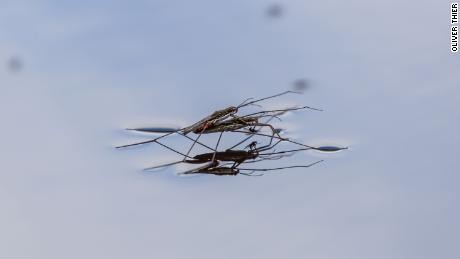
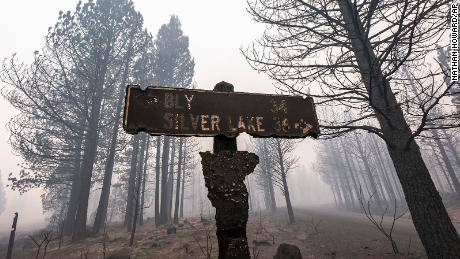


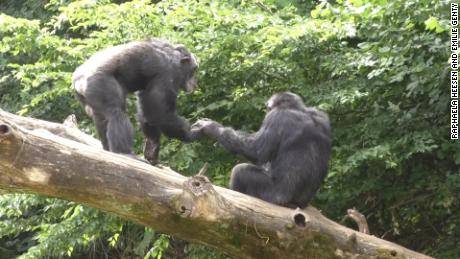


Write a Comment